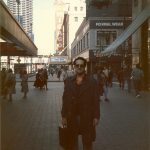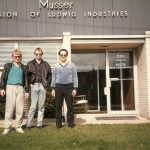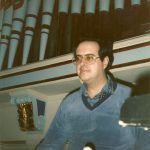My Musical Career|Part Thirty-Two
The Year 1987 – Part Three
Our First USA Tour – Part One
The year 1987 was indeed a pivotal year in so many ways, as I pointed out in the last two blog posts. So much happened that year, that in the recounting of events, I have had to spread it over three blog posts. Let’s hope that I can recount the events of the 1987 USA tour in this post and not have to spread it out to yet another post.
The 1987-88 season began on an ambivalent note. One the one hand, there was the preparation for the upcoming visit to the BBC Proms in August, as well as the anticipation felt by all members of the orchestra for the upcoming USA tour scheduled for late fall. On the other hand, there was the illness and death of our colleague Per Melsæter, which emotionally threw us timpani and percussion guys through a loop. Being the professionals that we were, we coped, and the tour to the BBC Proms was a great success. We returned to Oslo and paid our last respects to Per, and then got on with the business, as he would have wished us to do.
The orchestra had last visited the USA on tour back in the early seventies, under the direction of Mendi Rodan, a distinguished Israeli conductor. Even though that tour was very successful from most reports, it had been fourteen years since that tour and it was a much larger and much different ensemble that would be undertaking this tour.
The tour itself would last three weeks and would start in Chicago and we would work our way eastwards. The itinerary would include Ann Arbor, Detroit,and Muskegon, Michigan; Indianapolis, Indiana; Wheaton College, Wheaton, Illinois; Chicago, Illinois; Lima and Sandusky, Ohio; Providence, Rhode Island; C.W.Post College (now Long Island University) at Brookville, NY; Carnegie Hall in New York City and the tour would end in Lancaster, PA. We would use planes for the longest stretches of the tour, but a lot of it would be by bus.
The program, or should I say, programs were varied. The mainstays of the overall program were three symphonies: Sibelius Symphony No. 2; Shostakovich Fifth Symphony, and Tchaikovsky Fourth Symphony. In addition, Mariss programmed Tchaikovsky’s Romeo and Juliet Overture-Fantasy; Berlioz’ Roman Carnival Overture; Geir Tveitt’s Suite from The Hundred Hardangar Tones; and Egil Hovland’s Fanfare and Chorale as well as Verdi’s Overture to”Il Vespri Siciliani”. Quite a program, but there would be a lot of mix and matching this trip as there were a lot of concert days to fill. Since there was a lot of playing to do, and after consulting with my assistant, we decided that he’d do a bit of timpani playing on the tour. He’d play the Berlioz and Tveitt works, while I would do the rest. He also had plenty to do in the percussion section as well.
I decided that I’d use the Hingers on tour, so they were prepared accordingly. At the time, Iwas still using the Remo hazy heads with the false backbone, and was still unhappy with them, although I was able to get them to sound more than acceptable. As a matter of fact, I had made the decision to equip them with calfskin heads early in 1988 and was using this tour as the occasion to procure the necessary flesh hoops and skins. Before the tour, I contacted my mentor Dan Hinger and had the orchestra order from him the cadmium flesh hoops we would need to mount the heads. Also at his suggestion, I contacted Steve Polansky who was the proprietor of American Rawhide and ordered the necessary calfskin heads. Steve had supplied heads to Dan Hinger and Saul Goodman at the height of their careers and I was assured that the products would be of high quality. I would pick up the heads and flesh hoops at the end of the tour and I would sent them on ahead with the orchestra as I was staying on for a few days to visit family while the rest of the orchestra went on home.
I remember the flight over as being extra long. This is not because of the initial seven hour flight from Oslo Gardemoen to Newark Airport, but because a after a short layover, we would be going on to Chicago, which would be the base of operations for the first leg of our tour.
Seven hours flying with a half hour break, and then another three hours flying was not exactly a thrilling prospect for me, but I sucked it up and endued it, especially since I was back in the good old USA, this time on a professional basis!
Once we arrived in Chicago, we were taken tour hotel, which was the Congress Hotel on Lake Shore Drive, and this was our home for most of the next week. When we arrived in Chicago that first week in November, 1987, the city was in mourning for the death of it’s mayor, Harold Washington. He had died a day or two previous to our arrival and the city was still in a state of shock. The first African-American mayor of the city, he had been elected in 1983 and served a successful first term. He had been reelected the previous April and was just settling into his second term when he died of a heart attack at his desk at City Hall. The weather was glorious during our stay. It was an exceptionally mild November week with temperatures in the seventies. The Congress Hotel was a comfortable old-shoe hotel, one that had comfortable beds and after all that travel, we needed a good rest. If my recollection is accurate, we had a free day to ourselves just to get acclimated, and I used it to get familiar with the layout f the downtown area. The weather was so clear and warm that I still remember it almost thirty years on. I remember going to Miller’s Pub on Wabash Avenue it my good colleagues Jan Fredrik Christiansen (principal trumpet) and Aline Nistad (principal trombone) and had the best cheeseburger and fries lunch to date. We then checked out State Street – and the Chicago Theaters location. (That would be our Chicago venue for this tour.) If I remember correctly, we had a couple of free days in between visits to Muskegon and Indianapolis, and I used one of them to visit Steve Polansky at American Rawhide on the west side of Chicago. I took a cab to get there, and remember that it was in the third floor of an old building. Steve was about the same age as my father and had been in the business for many years, being the supplier of calfskin to most of the renowned American player of the day, including Saul Goodman and Fed Hinger. When I visited American Rawhide (Amrawco for short), Steve told me tht he was thinking of retiring and folding the business, what with the proliferation of plastic heads. That had really hurt his business, and it was becoming more of a burden to him. I believe that I was one of the last to get calfskins from him, and he was most gracious in helping me select the right ones. After we looked through what he had, I selected four skins of the recommended sizes and had them packaged up into a packing tube which I took with me. It was an interesting visit, talking with an old professional in his workplace, redolent of the smell of calfskins. Not as bad as a tannery, but you knew that there were a lot of rawhides being packaged and stored.
The trip there and back was typically Chicago – a mix of expressway and back streets that reminded me of the series Hill Street Blues – one of my all time favorites. Needless to say, I guarded that tube of skins with my life, until I handed it over to Atle, our extremely competent stage manager and keeper of the instruments.
Visit to Ludwig-Musser
On one of or other free days, I remember going with my assistant Trygve Wefring, percussionists Bjørn Løken and Morten Belstad out to the Ludwig Musser plant, then located in LaGrange, Illinois. The weather that whole period was gorgeous as I mentioned earlier, and we took a cab out to the plant. The sad fact
was that Ludwig had closed its historic North Damen Avenue factory about three years previously (after being bought out by C.G. Conn), and the timpani and mallet divisions were moved out to a one story factory/warehouse in LaGrange. (Nowadays, I believe most of the production comes out of North Carolina). We were treated cordially enough and given a tour of the facility. There wasn’t much going on at the time. We saw some timpani in various stages of assembly, including some timpani bowls being machine turned. There were also some vibes and marimbas in different stages of assembly, and we also saw the room where the kelon bars for marimbas and xylophones were made and stored.
I remember being somewhat impressed, but only somewhat as I am not a fan of kelon and was also disappointed that the firm was no longer in Chicago. Uusally, most change is for the best. At the time though, I felt that the change in Ludwig’s fortunes and operations was not for the best. Call me old-fashioned. I don’t mind. My colleagues and I enjoyed the outing and each other’s company, which was the main thing.
As I mentioned earlier, Chicago served as our base of operations for several concerts that we gave in the general vicinity. We gave concerts in Indianapolis, Muskegon, Michigan, Wheaton, Illinois as well as Chicago. The concert in Muskegon was memorable in the fact that it was held at a indoor events center that was used for ice hockey games. It seated 5,000, and for our concert a wooden floor was laid over the ice. The program featured the Shostakovich 5th Symphony as the main work. I don’t recall the other works on the program, but I do know the orchestra played a fine concert. Only about a thousand or so attended the concert, which was a little disheartening. However, as we were walking out of the arena on the way to the buses, a woman approached Mariss (who was walking beside me at the time) and she said: We really enjoyed the concert very much! You are so much better than this d****d hockey team of ours! Mariss kept a straight face and thanked her and as we moved on, said something to the effect “This was worth it! We are better than a hockey team!” and we both a good, long laugh. Still, I sensed he was a bit disappointed with the venue and arrangements in Muskegon. As a matter of fact, the arrangements for much of the tour were turning out to be less than we deserved. As we had not yet “earned our spurs” reputation-wise, we were given the “B”tour along with the venues to go with it. The only major places were Chicago, Ann Arbor, Detroit, Indianapolis, and New York. In addition, we played Wheaton, Illinois, Muskegon, Michigan (already described), Sandusky, Ohio, Providence, Rhode Island, Brookville, L.I., New York (C.W.Post), and Lancaster, Pennsylvania. It wasn’t so much the venues as the preparation or lack thereof that bothered us, particularly in Providence, where matters came to a head.
The concert in Wheaton was special in that my in-laws came to hear our orchestra and visit with me briefly. Tchaikovsky’s Fourth was the main work, and the college chapel was beautiful and easy to play in. Little did I know that I would play there again with the DuPage Symphony in the twenty-first century! It was good to see my parents-in-law, and they very much enjoyed the concert. The main event of this part of the tour was our concert in Chicago.
At the Chicago Theater
As I have mentioned earlier (probably more than once), we were on the “B’ touring circuit and instead of Orchestra Hall on Michigan Avenue, we were booked to perform at the Chicago Theater on State Street. It was, and is one of the city’s well-known theaters, but was not known for hosting visiting symphony orchestras. Nonetheless, we were booked and we rehearsed for the program, which was a tough program. We had two works on the program: Sibelius: Symphony No. 2, followed by the Shostakovich: Symphony No. 5. A big blow indeed! The stage was not very deep, so we felt a little crowded, but the acoustic was okay, and in the end the concert was well received. A contingent from the Chicago Symphony attended the concert (as they were free that night), including the legendary Adolph “Bud” Herseth, the principal trumpet of the CSO. He was mentor to our own excellent principal trumpet, and was more than complimentary to all of us. He was quite enthusiastic as a matter of fact. We were buoyed up by the fact that such a distinguished musician would take the time to hear us, and by the excellent reception we received in Chicago. After that concert, it was time to head eastward.
Ann Arbor and Detroit
Ann Arbor and Detroit were next up on our schedule. Our concerts in Ann Arbor and Detroit were quite eventful. Hill Auditorium at the University of Michigan is a great venue to play, the acoustics being very good, and it has that marvelous organ to the rear of the stage. When we performed at Hill Auditorium, both in 1987 and again in 1994, the pipes had an interesting color scheme. These are the façade pipes, which are non speaking. I do know that the program was well received and the orchestra played wonderfully. What I remember most about that visit was the chance to visit the music building on our off day, and I first saw and heard artificial skin heads on Hinger timpani. These were Asai heads, and they sounded fairly well. The Renaissance heads by Remo had not yet come on the market and these seemed like an alternative to the Remo heads which I was using and which were at the time so hit and miss, I also had the pleasure to meet Marilyn Mason, then the University’s organist. As a former choir boy who grew up literally in n organ loft, (my brother was a church organist for over thirty years) I had a natural interest in all things concerning the pipe organ, and had heard of Dr. Mason. She was very gracious and we had a delightful conversation, which resulted in her inviting me to play a beautiful new tracker pipe organ that had just been completed. It was a beautiful instrument, and while I play the organ mainly by ear, I managed to coax some decent sounds out of it. She was most kind, and I think she thought I was better than I really was, but I am a good “faker”, and didn’t embarrass myself. She left me to my own devices, and I played the organ for over half an hour. It was wonderful! The other thing that comes to mind is what happened after our concert. We were given a fantastic dinner at the hotel in the ball room by the promoters of the event, and we had a great meal. However, the dinner turned into a laughter fest. We were all tired, and looking back on it, maybe a little punch drunk. One of the orchestra members had a distinctive laugh – it was so funny and infectious, that when he laughed at something at the dinner table, others started laughing, and it spread like a wildfire! Soon the whole room was laughing uncontrollably! I had never before seen or experienced anything remotely like it. But it was fun! Our next venue was Detroit, where we played at Orchestra Hall on Woodward Avenue. It was once the venue of the Detroit Symphony, but it had seen better days, and in any case, the DSO was at the time playing in another venue. The concert featured the Shostakovich 5th Symphony, and we played the heck out of it. Despite the Hall’s careworn appearance, it had splendid acoustics, and we just loved it! The concert was also the first opportunity to meet with and talk with Salvatore Rabbio, then timpanist of the Detroit Symphony and one of my favorite players. He attended the concert and was most impressed with Mariss and the orchestra and was most complimentary toward yours truly. He also filled me in at that time about the hall and why the orchestra was playing elsewhere. We talked for quite some time and set the stage for a relationship that would develop over time. It was just great. The next day, we continued our eastward progress. That I’ll cover in the next blog. This one is long enough.




Recent Comments